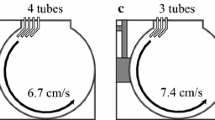Abstract
To determine an optimal temperature range for efficient production of healthy eel larvae Anguilla japonica, the effect of water temperature on hatching, survival, and deformity rates was examined. The early ontogeny of morphological features in this species by incubating eggs at five different temperatures (19, 22, 25, 28 and 31 °C) was examined. Hatching occurred at 24, 28, 46 and 58 h after fertilization when incubated at 28, 25, 22 and 19°C, respectively; no eggs hatched at 31°C The growth rate of prefeeding larvae increased as water temperature was elevated and acquisition of feeding ability was also accelerated at higher temperature. Significantly high hatching rates (76–86°, P<0.05) and survival rates (61–86%, P<0.05) were observed at relatively high temperatures (22–28°C). The deformities were ‘open lower jaw’, ‘pericardial edema’, and ‘notochordal bending’, in which the mouth was deformed with a downward projecting lower jaw, the pericardial cavity was swollen, and the notochord was bent or twisted to various degrees, respectively. Open lower jaw and pericardial edema were especially predominant at 19°C, with rates of 68 and 92%, respectively, compared with 31 and 10% at 25 and 28°C, respectively. The occurrence of notochordal bending was not affected by temperature. The optimal temperature for incubation and rearing A. japonica eggs and prefeeding larvae is approximately 25–28°C.
Similar content being viewed by others
References
Tatsukawa K Eel resources in East Asia. In Aida K, Tsukamoto K, Yamauchi K (eds). Eel Biology Springer, Tokyo. 2003; 293–298.
Tanaka H, Kagawa H, Ohta H, Unuma T, Nomura K The first production of glass eel in captivity: fish reproductive physiology facilitates great progress in aquaculture. Fish Physiol. Biochem. 2003; 29: 493–497.
Furuita H, Ohta H, Unuma T, Tanaka H, Kagawa H, Suzuki N, Yamamoto T Biochemical composition of eggs in relation to egg quality in the Japanese eel, Anguilla japonica. Fish Physiol. Biochem. 2003; 29: 37–46.
Seoka M, Yamada S, Iwata Y, Yanagisawa T, Nakagawa T, Kumai H Differences in the biochemical content of buoyant and non-buoyant eggs of the Japanese eel, Anguilla japonica. Aquaculture 2003; 216: 355–362.
Unuma T, Kondo S, Tanaka H, Kagawa H, Nomura K, Ohta H. Relationship between eggs specific gravity and egg quality in the Japanese eel, Anguilla japonica. Aquaculture 2005; 246: 493–500.
Ohta H, Higashimoto Y, Koga S, Unuma T, Nomura K, Tanaka H, Kagawa H, Arai T Occurrence of spontaneous polyploids from the eggs obtained by artificial induction of maturation in the Japanese eel (Anguilla japonica). Fish Physiol. Biochem. 2003; 28: 517–518.
Tsukamoto K Spawning of eels near a seam ount. Nature 2006; 439: 929.
Shinoda A, Tanaka H, Kagawa H, Ohta H, Tsukamoto K. Otolith micros tructural analysis of reared larvae of the Japanese eel Anguilla japonica. Fish. Sci. 2004; 70: 339–341.
Tanaka H. Rearing of eel larvae. In: Tabeta O (ed.). Early Life History and Prospects of Seed Production of the Japanese Eel Anguilla Japonica. Kouseisya-Kouseikaku Press, Tokyo. 1996; 119–127.
Chang SL, Kou GH, Liao IC Temperature adaptation of the Japanese eel (Anguilla japonica) in its early stages. Zool. Stud. 2004; 43: 571–579.
Yamamoto K, Yamauchi K Sexual maturation of Japanese eel and production of eel larvae in the aquarium. Nature 1974; 251: 220–222.
Yamauchi K, Nakamura M, Takahashi H, Takano K Cultivation of larvae of Japanese eel. Nature 1976; 263: 412.
Wang YQ, Zhao CC, Shi ZF, Tan YJ, Zhang KJ, Li YS, Yang YJ, Hong YT Studies on the artificial inducement of reproduction in common eel. J. Fish. China 1980; 4: 147–156.
Yu TC, Tsai CL, Tsai YS, Lai JY Induced breeding of Japanese eels, Anguilla japonica. J. Taiwan Fish. Res. 1993; 1: 27–34.
Tanaka H, Kagawa H, Ohta H Production of leptocephali of Japanese eel (Anguilla japonica) in captivity. Aquaculture 2001; 201: 51–60.
Ohta H, Kagawa H, Tanaka K, Okuzawa K, Iinuma N, Hirose K. Artificial induction of maturation and fertilization in the Japanese eel, Anguilla japonica. Fish Physiol. Biochem. 1997; 17: 163–169.
Kagawa H, Tanaka T, Ohta H, Okuzawa K, Iinuma N. Induced ovulation by injection of 12,20\-dyhydroxy-4-pregnen-3-one in the artificially matured Japanese eel, with special reference to ovulation time. Fish. Sci. 1997; 63: 365–367.
Dou SZ, Yamada Y, Okamura A, Shinoda A, Tanaka S, Tsukamoto K. Temperature influence on the spawning performance of artificially-matured Japanese eel Anguilla japonica in captivity. Envir. Biol. Fish. 2007; DOI: 10.1007/s10641-007-9268-8 (in press).
Okamura A, Zhang H, Yamada Y, Tanaka S, Horie N, Mikawa N, Utoh T, Oka HP Re-examination of the spermatozoal ultrastructure of eels: observations of the external morphology of spermatozoa in three species. J. Fish Biol. 2000; 57: 161–169.
Unuma T, Kondo S, Tanaka H, Kagawa H, Nomura K, Mikawa N, Determination of the rates of fertilization, hatching and larval survival in the Japanese eel, Anguilla japonica, using tissue culture microplates. aquaculture 2004; 241: 345–356.
Ricker WE. Growth rates and models. In: Hoar WS, Randall DJ, Brett JR (eds). Fish Physiology, VIII. Academic Press, New-York, NY. 1979; 676–743.
Klimogianni A, Koumoundouros G, Kaspiris P, Kentouri M. Effects of temperature on the egg and yolk-sac larval development of common pandra, Pagellus erythrinus. Mar. Biol. 2004; 145: 1015–1022.
Ottesen OH, Bolla S Combined effects of temperature and salinity on development and survival of Atlantic halibut larvae. Aquacult. Int. 1998; 6: 103–120.
Wang LH, Tsai CL Effects of temperature on the deformity and sex differentiation of tilapia, Oreochromis mossambicus. J. Exp. Zool. 2000; 286: 534–537.
Brown CL, Nunez JM. Disorders of developments. In: Leatherland JF, Woo PTK (eds). Fish Disease and Disorder, Vol. 2. Non-Infectious Disorders. CAB International Publication. Wallington, NJ, USA, 1998; 1–18.
Inagaki T, Hasumoto H, Inoue T Hydrographic measurements of KH-98-2 cruise. In: Inagaki T, Tsukamoto K (eds). Preliminary Report of the Hakuho-Maru Cruise KH-98-2 (Eel Cruise VIII). Ocean Research Institute, Tokyo. 2000; 10–12.
Author information
Authors and Affiliations
Corresponding author
Rights and permissions
About this article
Cite this article
Okamura, A., Yamada, Y., Horie, N. et al. Effects of water temperature on early development of Japanese eel Anguilla japonica . Fish Sci 73, 1241–1248 (2007). https://doi.org/10.1111/j.1444-2906.2007.01461.x
Received:
Accepted:
Issue Date:
DOI: https://doi.org/10.1111/j.1444-2906.2007.01461.x




